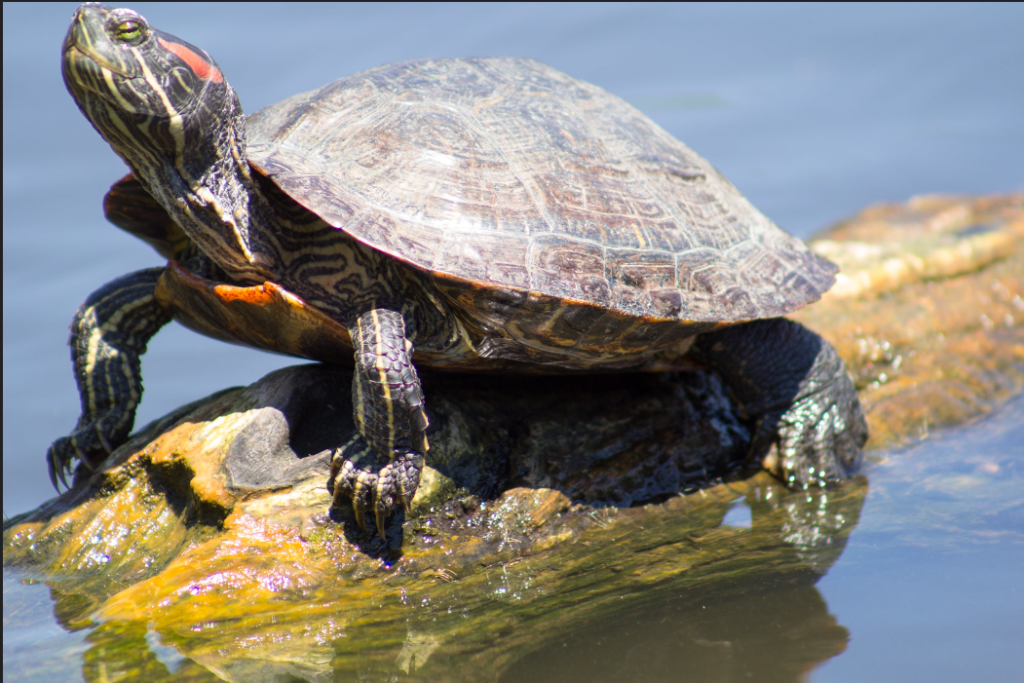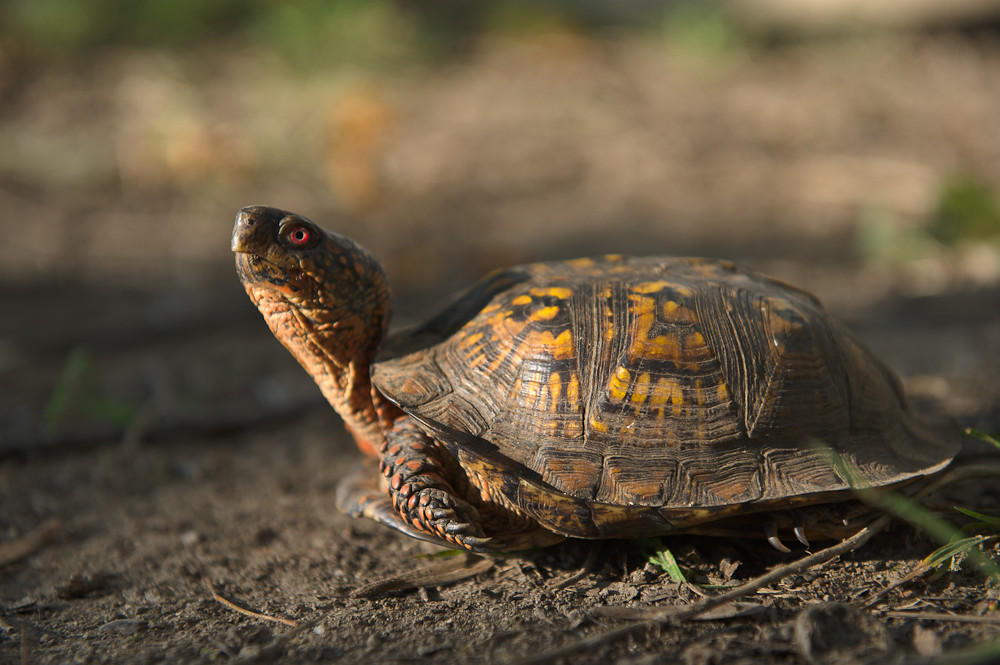A turtle stretches its neck to regulate its body temperature and during mating rituals. Turtles also stretch their neck to explore their surroundings and to show aggression towards other animals.
It is normal behavior unless accompanied by other worrying signs. Turtles are fascinating creatures with unique habits and behaviors. As a pet owner, it is important to understand why your turtle exhibits certain actions, such as stretching its neck. While this behavior is normal in some instances, it could also be an indication of a health problem.
In this article, we will explore the reasons why turtles stretch their necks, what signs to look out for, and what to do if you suspect your turtle is unwell. Understanding your pet’s behavior is key to providing proper care and ensuring their well-being.

Credit: Dan Soto
Anatomy And Physiology Of Turtles
Discussion Of The Unique Features Of Turtles
Turtles have evolved some unique features that allow them to distinguish themselves from other animals. Here are some of the most noteworthy features:
- Turtles are the only reptiles with shells that protect their vital organs.
- Turtles’ temperature is influenced by their environment, which helps regulate their metabolic rate.
- Turtles have a beak-like mouth that doesn’t have teeth, but instead allows them to grasp and crush their food.
Examination Of The Anatomy Of A Turtle’S Neck
A turtle’s neck is a remarkable aspect of its anatomy. Here are the key features of a turtle’s neck:
- A turtle’s neck is made up of eight to nine vertebrae, allowing it to retract or extend its head, unlike most other reptiles.
- The cervical vertebrae are flattened and have broad, bony processes to support the muscles and protect the arteries.
- The neck muscles are used to move the head and neck sideways, forwards and backward, and allow the turtle to capture and swallow its food.
Explanation Of How A Turtle’S Neck Functions
A turtle’s neck is an extraordinary structure that has evolved to perform many important functions. Here is how a turtle’s neck functions:
- Turtles retract their necks inside the shell when they sense danger, and can use the neck’s flexibility to extend it far outside the shell to reach prey or plants.
- The neck muscles work together to allow the turtle to perform these movements with ease and precision.
- Turtles’ neck function also helps them protect themselves from predators, dig nesting burrows, and establish dominance during mating season.
With these unique features, remarkable anatomy, and multiple purposes, the turtle’s neck is an essential feature of its body and survival.
Reasons Why Turtles Stretch Their Necks
Stretching is a common behavior in turtles, but do you ever wonder why your pet turtle stretches its neck? Well, there are reasons why turtles stretch their necks, and we’re going to explore them in this blog post. Let’s dive in!

Credit: Jon Beard
Analysis Of The Various Reasons Turtles May Stretch Their Necks
- Turtles stretch their necks to thermoregulate their body temperature. Their necks are used to move their bodies closer or further from a heat source. When they need to warm up, they stretch out their necks to bask under the sun. On the other hand, when they need to cool down, they stretch down their necks to dip themselves in the water.
- Turtles also stretch their necks to maintain their health. Stretching helps them to exercise their neck muscles, improving their flexibility. It can also help to prevent cramps and stiffness from developing in their neck muscles.
Overview Of The Different Turtle Species And Their Behaviors
Different turtle species have varying behaviors, so it’s worth observing their stretching habits to determine what they mean. Here are some common behaviors for various turtle species when stretching their necks:
- Red-eared sliders may stretch their necks to show dominance over their tankmates or to attract a mate.
- Desert tortoises stretch out their necks to raise their body temperature in the morning.
- Sea turtles stretch their necks when they emerge from the water to breathe air. They also stretch out their necks when they lay eggs on land.
Explanation Of How Stretching May Differ Depending On The Species And Environment
The way turtles stretch their necks can differ depending on their species and the environment they live in. For example:
- A turtle living in captivity may not have access to a variety of environments, which may affect its stretching habits.
- Turtles living in water will stretch their necks to reach the surface to breathe, while those living on land will stretch their necks to bask in the sun.
- Different species will have unique stretching behaviors. Some turtle species, like snapping turtles, may only stretch their neck when they feel threatened or need to attack, while others, like box turtles, may stretch their necks just as a part of their daily routine.
Overall, there are several reasons why turtles stretch their necks, and it’s essential to pay attention to their behavior to understand what they’re trying to communicate. It’s best to provide an environment that allows them to move around freely and bask in the sun and water to promote a healthy lifestyle.
Stretching For Basking
Description Of How Turtles Use Stretching While Basking
When a turtle stretches its neck while basking, it is usually trying to absorb more heat from the sun or a heat lamp. Stretching not only helps a turtle increase its surface area, allowing for more absorption, but it also helps stimulate its muscles and promotes overall flexibility.
Stretching while basking can also help turtles with digestion by promoting blood flow to their stomachs.
Some key points include:
- Stretching is a common behavior for turtles while basking
- Stretching promotes flexibility and can stimulate muscles
- Stretching while basking can help with digestion
Explanation Of Why Turtles Require Basking To Regulate Their Body Temperature
Turtles are ectothermic, meaning their body temperature is regulated by their environment rather than by producing their own heat like mammals. Basking allows turtles to regulate their body temperature by absorbing heat from the sun or another heat source and then retreating to cooler areas when they become too hot.
Without basking, turtles would be unable to regulate their body temperature, which could lead to numerous health problems.
Some key points include:
- Turtles are ectothermic and rely on their environment to regulate their body temperature
- Basking allows turtles to absorb heat and then cool off as needed
- Without basking, turtles can experience health problems related to body temperature regulation
Importance Of Basking For The Health Of A Turtle
Basking is essential for the overall health of a turtle. By regulating their body temperature through basking, turtles are able to boost their immune systems, improve digestion, and even synthesize vitamin d. turtles that don’t bask enough can become susceptible to illnesses and may even experience malnutrition.
Some key points include:
- Basking is crucial for a turtle’s immune system, digestive health, and vitamin d synthesis
- Turtles that don’t bask enough can become ill or malnourished
- Regular basking is necessary for maintaining a healthy turtle.
Stretching For Communication
Examination Of The Social Behavior Of Turtles
Turtles are fascinating creatures that have captivated humans for centuries. One aspect of their behavior that is particularly intriguing is the way they stretch their necks. While it may seem like a simple movement, stretching is actually an important form of communication for turtles.
To understand why turtles stretch their necks, we must first examine their social behavior.
Discussion Of How Stretching Serves As A Form Of Communication
Turtles use stretching as a way to communicate with other turtles. Stretching can convey a message of dominance, submission, or even aggression. Different stretching behaviors are used depending on the situation, and it is important for turtles to be able to interpret these behaviors to avoid conflicts.
Overview Of Specific Communication Signals Sent Through Stretching
Turtles use stretching to communicate a variety of messages. Some common signals include:
- Aggression: When a turtle feels threatened, it may stretch its neck out and open its mouth wide to show its opponent that it is ready to fight.
- Submission: In contrast, a submissive turtle may retract its neck and tuck in its head to show that it is not a threat.
- Courtship: During courtship, male turtles may stretch their necks and bob their heads to attract a female’s attention.
- Territory marking: Turtles may stretch while on land to mark their territory. By stretching their necks, they are able to reach higher surfaces and leave their scent behind.
Explanation Of How Stretching Can Indicate Dominance Or Submission
Stretching is an important signal of dominance or submission in turtle behavior. When two turtles encounter each other, they may engage in stretching behaviors to establish their rank in the social hierarchy. Dominant turtles will often stretch more aggressively, while submissive turtles will retract their necks to avoid conflict.
This helps the turtles to avoid physical fights and maintain social order.
Turtles are fascinating creatures with complex social behaviors. By understanding why turtles stretch their necks and what these behaviors mean, we can gain a deeper appreciation for these fascinating animals.
Stretching For Foraging
As a turtle owner, you may have noticed your pet turtle stretching its neck to reach for something. Turtles use stretching not only for basking in the sun and for locomotion, but also for foraging for food. Here’s how turtles use stretching while foraging for food:
How Turtles Use Stretching While Foraging For Food:
When turtles stretch their neck, they are not only extending their range of vision, but also their foraging range. The horizontal movement of their necks allows them to move around and search for food without moving their entire body.
Explanation Of How Stretching Allows Turtles To Reach Further:
Stretching enables turtles to reach further distances, thus allowing them to access a wider variety of food. This is especially important since turtles require a diverse diet to maintain optimal health. Without the ability to stretch, they might miss out on important nutrients found in food outside of their immediate reach.
Here are some typical situations when turtles use stretching while foraging for food:
- When they are competing with other turtles for food, they may need to stretch and reach out to feed on prey.
- When the food supply is scarce, turtles may need to stretch to access small crevices that have not been depleted by other foragers.
- When their diet lacks in certain vitamins or minerals, turtles may stretch their necks further to reach for food that provides them with those missing nutrients.
Importance Of Range In Turtle Diet:
Having a range of food in their diet is crucial for turtles, as their dietary needs vary by species, age, and living conditions. Turtles are omnivores, so their diet should consist of both plant and animal-based foods. Additionally, they need a variety of nutrients, such as protein, vitamins, fiber, and calcium, so they can maintain a healthy shell, digestive system, and overall health.
Here are some examples of what typical turtle diets contain:
- Aquatic turtles: They need plants like water lettuce and duckweed, as well as invertebrates like crickets, worms, and shrimp.
- Tortoises: Their diet includes grasses, hay, fruits, and vegetables.
- Semi-aquatic turtles: They require a combination of aquatic and terrestrial foods in their diet, such as fish, insects, fruits and vegetables.
Turtles stretch their necks while foraging for food to reach a wider variety of food sources, including those that are beyond their immediate reach. Having range in their diets is important for maintaining their health and well-being. By providing a diverse range of foods, you can help ensure your turtle gets all of the necessary nutrients it needs to thrive.
Signs Of Illness In Turtles
It’s not uncommon to see your pet turtle stretch his neck, but have you ever wondered why he may be doing it? While it could simply be a result of your turtle being active, it could also be a sign of an underlying health issue.
We’ll discuss how to recognize unusual stretching behaviors in your turtle and provide an overview of potential health issues that may be causing them.
Discussion On How To Recognize Unusual Stretching Behaviors
Turtles may stretch their necks for a variety of reasons, so it’s important to pay attention to any unusual behaviors. Some signs to look out for include:
- Your turtle is constantly stretching its neck, even when inactive
- Your turtle’s neck appears to be longer than usual
- Your turtle is struggling to retract its neck back into its shell
- Your turtle is displaying other signs of illness, such as lethargy or loss of appetite
If you notice any of these behaviors in your turtle, it’s important to seek veterinary care as soon as possible.
Overview Of Potential Health Issues
There are several health issues that could be causing your turtle to stretch its neck, such as:
- Respiratory infections: These infections can cause your turtle to stretch its neck in an effort to breathe more easily.
- Vitamin a deficiency: This condition can cause your turtle’s neck to become weak, making it difficult for them to retract it into their shell.
- Shell injuries: If your turtle has a shell injury, they may stretch their neck in an attempt to relieve any discomfort.
- Parasites: Parasites such as tapeworms or mites can cause your turtle to stretch its neck or exhibit other unusual behaviors.
- Dental issues: Dental problems can cause your turtle to stretch its neck in pain or discomfort.
If you suspect that your turtle may be suffering from any of these issues, it’s important to consult with a veterinarian who specializes in reptile care.
Explanation Of The Role Of Stretching In Detecting Illness
While it’s not always a cause for concern, your turtle stretching its neck could be an indication of an underlying health issue. Observing your turtle’s behavior regularly can help you detect any unusual stretching patterns and identify potential health concerns early on.
Remember to take your turtle for regular health check-ups with a vet experienced in treating reptiles, and to monitor their behavior on a daily basis.
Knowing what signs to look out for and seeking veterinary care when necessary can help ensure your turtle lives a long, healthy life.
Frequently Asked Questions Of Why Does My Turtle Stretch His Neck
Why Does My Turtle Stretch His Neck?
Turtles stretch their neck to take in air and bask in the sun.
When Should I Worry About My Turtle Stretching His Neck?
If your turtle stretches his neck for extended periods, or with visible discomfort, consult a veterinarian.
Is Neck-Stretching For Turtles Normal?
Yes, neck stretching is normal for turtles as they use it to regulate body temperature.
What Can I Do To Facilitate My Turtle’S Neck-Stretching Instinct?
Ensure that your turtle’s basking area is well lit and that it has access to clean air.
Can Neck-Stretching Lead To Any Medical Issues?
Neck-stretching itself is not a problem, but underlying respiratory or muscular diseases could cause excessive stretching.
Conclusion
To conclude, turtles are fascinating creatures and their stretching habits are simply a natural part of their behavior. Stretching their necks is nothing to worry about, as long as they appear healthy and active otherwise. From reaching for food to basking in the sun, turtles stretch for various reasons.
These incredible creatures have adapted to their environment in extraordinary ways, and their necks are just one example of their distinctive characteristics. If you have any concerns about your pet turtle’s behavior, it’s always best to consult with a veterinarian or an experienced turtle owner for guidance.
Recent Posts
Turtles headbutt black things due to their instinctual response to threats or territorial disputes. When turtles encounter black objects, they may perceive them as intruders or competitors, leading...
To fix a hole in a turtle shell, clean the wound thoroughly and apply adhesive or a patch specifically designed for shell repairs. Then monitor the turtle for any signs of infection or further...

